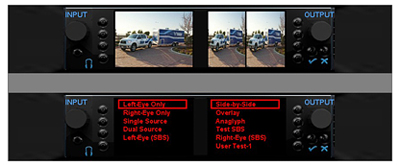3G's Pathway to 3DTV
ALEXANDRIA, VA.
Prior to NAB last year, the buzz was all about 3Gbps equipment for HD. Even in a weakened economy, consumers were continuing to snap up HDTV sets. Over-the-air broadcasters had paid for much of the early cost of developing 720p and 1080i HD equipment. Now they were beginning to see the need for the higher bandwidth of 1080p as a way to future proof their facilities' production needs. They joined the rank and file of the production and distribution outlets that already understood the value of 3Gbps infrastructure.
Content acquisition and production companies with their own trucks have been on board with the idea the longest. With entertainment and sporting events being the early adopters for broadcasting HD on satellite and cable, the OB truck market was aggressively updating its fleets to be 3Gbps-capable for HD productions.
Just as 3Gbps was coming into acceptance late last year, a new challenge presented itself to the broadcast community.
"As early as fall last year most broadcasters were still thinking only along the line of HD and 3G, not really 3DTV," said Mo Goyal, master control and branding product manager for Canadian-based equipment manufacturer Evertz.
Then along came the big 3DTV distribution announcement from satellite broadcaster BskyB and a little movie called "Avatar." "With the advent of Ava-tar and the announcement of several big players at the CES show, the interest and momentum in 3DTV really picked up," Goyal said.
At this year's NAB Show, equipment manufacturers will be going all out to showcase and explain how their equipment is not only 3Gbps compliant, but also ca-pable of making the 3Dtv production process possible.
MAKING IT POSSIBLE
Montreal-based broadcast equipment manufacturer Miranda has been producing HD and 3Gbps capable equipment for many years and believes that this year 3G will be all about 3D, as the interest in 3DTV (stereoscopic television) is moving even faster than the adoption of HD.
Michel Proulx, Miranda's chief technology officer has been with the company for more than a decade and has worked through the slow adoption of HD by the traditional broadcaster. "The business model just wasn't there," he said. When ESPN began to pursue HD, he felt that the move made sense.
"This time around the right people are going first," he said. Specifically, Proulx is seeing the sports and entertainment industries as the ideal early adopters as they have a business model already in place. "There are three potential reasons for needing 3Gps infrastructure: 1080p 50/60 HD, 4:4:4 sampling for produc-tion, and dual HD streams on a single wire for 3D."
For production trucks, the ability to use the 1080p signal is a must, so they are opting to stay with the dual-link model that allows them to move the 3D sig-nal on two separate wires, keeping the right eye and left eye signal discrete. They move these signals from cameras already dual-link-capable through 3G routers and then switch them through 3G switchers capable of buss-linking. This workflow also allows them to use existing graphics packages via their switcher, which is not yet an option with single-wire 3DTV.

Ray Baldock, CTO, Grass Valley For those looking to do 3DTV and are already operating at 720p or 1080i, 3Gbps makes 3DTV an easy transition. "3DTV validates the importance of a 3Gps infra-structure," said Grass Valley's Chief Technical Officer Ray Baldock. "You can run the left eye/right eye signals at full bandwidth without any horizontal compression over a single coax link." This will allow broadcasters who have already built a 3Gbps capable plant to move a 3Dtv signal through it.
IMPLEMENTING 3GBPS FOR 3DTV
"The term 3DTV can be confusing," said Stan Moote, vice president of corporate development for Harris Broadcast. He explains that many graphics sys-tems, including Harris Broadcast's have been producing three dimensional graphics for years, and that stereoscopic technology itself has been around and in use for more than 50.
Not only are the terms 3D and 3DTV different, but the way in which the signal can be carried through a plant is different as well. The one constant though is that 3Gbps infrastructure will allow for optimal management of HD and 3DTV within a plant, and allow for the most options. "The more savvy customers under-stand all [of] the salient features of 3Gbps signal management, and [they] are making sure that they are being picked up when designing their plants both for HD and 3DTV," said Moote.
Systems integrators (SI) are frequently relied upon to provide expert direction when building a 3Gbps facility. AZCAR, the Ontario-based SI has been working with customers interested in 3Gbps plants for several years. "While some of our clients put 3 Gig into a proposal or specification by saying '3 Gig ready' or '3 Gig compliant' the definition of what that means is still nebulous," explains Karl Paulsen, AZCAR CTO and TV Technology columnist.
This is why the expertise of both a systems integrator and a knowledgeable equipment vendor is critical. For those wanting a better understanding of the benefits of the technology as well as the limitations, Paulsen and three other SMPTE members (Society of Motion Picture and Television Engineers) collaborated on a technical paper. "Considerations in Physical Infrastructures for 3 Gbit/sec Systems Design" is a must-read for any organization looking to move into 3 Gbps or 3DTV.
Within the SMPTE 3 Gbps spec itself, there are several different forms a signal can take. Each of these must be thoroughly understood in order for an engi-neer to make the correct choice of which to implement. "The SMPTE 3 Gbps spec for level B makes transmitting a 3DTV signal a lot easier," explains Evertz' Goyal. Where level A accommodates a single HD signal up to 3Gbps, the level B has two separate HD signals that can accommodate two uncompressed HD signals. The limitation here is the fact that the data rate of these two signals can only add up to 3Gbps, so only facilities using 720p, 1080i and 1080p/24 as their 3DTV acquisition signals can put them onto a single cable.
WHO IS SEEING STEREOSCOPIC?
Certain types of content lend themselves to 3DTV better than others, according to Moote. "It takes time for the eye to lock onto and enjoy the 3D expe-rience, [so] fast paced news broadcasts with lots of changing shots won't benefit from 3DTV," he said, adding that movies and sporting events where depth of field can be controlled and 3D enhancements added appropriately make the most sense.
"A 3DTV broadcast of a sporting event requires a separate truck that is just shooting for 3D," he continued. This is not because the equipment is neces-sarily different, since the same cameras, routers and switchers can be used for both, but because the choice of shots will vary. Wide stadium shots have no value in HD and can throw off the eye, where close-ups that allow the depth of field to be showcased make the experience worthwhile. Moote said that due to the limited benefits of 3D technology in TV news, local TV is not excited about the 3DTV right now.
Equipment manufacturers though are very excited. "I have gone from a stereoscopic skeptic to a stereoscopic evangelist," says Miranda's Proulx. He says that manufacturers are trying to position themselves with the right products for the marketplace. "Today most of the interest in stereoscopic is com-ing from production trucks," he said. Miranda is supplying many of them with their 3D capable multiviewer shown at last year's NAB Show.
Carl Dempsey, CEO of Wohler Technologies in San Francisco is guiding his company to take advantage of the needs of in-depth monitoring of 3DTV signals, both in trucks and facilities. "We're a monitoring company and pride ourselves on being able to monitor everything a broadcaster needs," said Dempsey. He recently hired expertise away from Dolby's 3D lab to help Wohler focus on several new products, showing just how competitive the market for 3DTV technology may be-come. At the NAB Show, Wohler will show a proof-of-concept 3DTV monitoring display that will not only let users view the images in 3D, but also analyze their composition. This ability to look at the individual left and right eye images, as well as monitor a 3DTV signal in whatever format is in use, will be a valuable tool to those beginning to adopt a 3DTV workflow.

At NAB, Wohler will show a proof-of-concept 3DTV monitoring display that will not only let users view the images in 3D, but also analyze their composition. Evertz, which helped ESPN build one of the first fully operational 3Gbps facilities in the United States, is another example of how vendors are working more closely than ever with their clients to develop products that solve specific technology issues. For example, rather than having to find a complement of different vendors' equipment to solve a problem, many manufacturers are now working in tandem with their clients to develop problem-specific solutions. "We worked with ESPN to come up with a number of products for them to complete their 3G facility in Los Angekes," said Goyal. "We look at this facility as our showcase for 3G technology." Evertz is once again working with ESPN on a 3G build at their Bristol Conn. facility that will have an added 3DTV component.
CAUTION AHEAD
Whether looking ahead to 3DTV or just trying to make sure your facility is 3 Gbps-capable, those with 3Gbps experience tell buyers to educate themselves and perform their due diligence. "Care must be given to examining products which claim to be 3 Gig-ready," warns AZCAR's Paulsen. "Some of these products are not what they claim [to be]."
The concern is that one vendor's meaning of 3 Gig may be very different than another's. Some vendors have equipment with internal processors working in a 3 GHz clock environment, but the signal receivers and drivers may not be up to the 3Gbps spec, leaving a weak link in a 3 Gbps signal chain.
Monitors also can be a problem in a 3Gbps plant, specifically with what segment of the SMPTE 424 and 425 spec that they will actually process. This will become even more of an issue if the 3Gbps plant is also looking at doing 3DTV.
The good news is that many vendors are taking a proactive role in educating clients on the new technologies as well as their own product lines. It is also a good sign that more and more vendors are not only willing, but wanting to work with their clients on developing products that fit their specific needs. As 3DTV blazes ahead this year, those organizations that are already looking at or implementing 3 Gbps technology are likely to be one step ahead of the rest.
The professional video industry's #1 source for news, trends and product and tech information. Sign up below.

